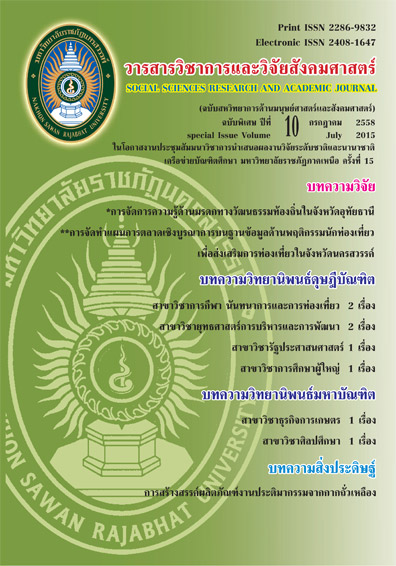การพัฒนาคู่มือการจัดทำแผนพัฒนาผู้ตรวจสอบภายในรายบุคคล โดยอิงเกณฑ์สมรรถนะหลักสำหรับผู้ตรวจสอบภายใน; The Development of Individual Development Plan Handbook,based on the Core Competencies for Internal Auditor
Main Article Content
Abstract
บทคัดย่อ
การวิจัยครั้งนี้มีวัตถุประสงค์เพื่อ 1) สร้างแนวทางการจัดทำแผนพัฒนาผู้ตรวจสอบภายในรายบุคคล 2) สร้างคู่มือการจัดทำแผนพัฒนาผู้ตรวจสอบภายในรายบุคคลโดยอิงเกณฑ์สมรรถนะหลักสำหรับผู้ตรวจสอบภายใน และ 3) ตรวจสอบความเป็นไปได้ในการนำคู่มือไปใช้และวิเคราะห์ลักษณะการพัฒนาตนของผู้ตรวจสอบภายใน การวิจัยนี้เป็นการวิจัยและพัฒนา แบ่งเป็น 4 ขั้นตอน คือ 1) สร้างแนวทางการจัดทำแผน พัฒนาผู้ตรวจสอบภายในรายบุคคล ด้วยเทคนิคเดลฟายโดยผู้เชี่ยวชาญจำนวน 19 คน 2) สร้างคู่มือและตรวจสอบคุณภาพคู่มือโดยผู้เชี่ยวชาญจำนวน 5 คน 3) การตรวจสอบความเป็นไปได้ในการนำคู่มือไปใช้และวิเคราะห์ลักษณะการพัฒนาตนของผู้ตรวจสอบภายในโดยเลือกกลุ่มตัวอย่างที่เป็นผู้ตรวจสอบภายในแบบเฉพาะเจาะจง จำนวน 30 คน เครื่องมือที่ใช้ คือ แบบประเมินแบบมาตราส่วน 5 ระดับ วิเคราะห์ข้อมูลด้วยค่าเฉลี่ย ค่ามัธยฐาน ค่าฐานนิยม และค่าพิสัยระหว่าง ควอไทล์ เครื่องมือที่ใช้ คือ แบบประเมิน IOC และแบบมาตราส่วน 5 ระดับ วิเคราะห์ข้อมูลด้วยค่าเฉลี่ยและส่วนเบี่ยงเบนมาตรฐาน เครื่องมือที่ใช้ คือ แบบประเมินแบบมาตราส่วน 5 ระดับ วิเคราะห์ข้อมูลด้วยค่าเฉลี่ย ส่วนเบี่ยงเบนมาตรฐาน ร้อยละและความถี่ 4) จัดสนทนากลุ่มโดยผู้เชี่ยว ชาญจำนวน 8 คน วิเคราะห์ข้อมูลด้วยการวิเคราะห์เนื้อหา
ผลการวิจัยพบว่า
แนวทางการจัดทำแผนพัฒนาผู้ตรวจสอบภายในรายบุคคล ประกอบด้วย 3 หัวข้อ คือ 1) ขั้นตอนในการจัดทำแผนพัฒนาผู้ตรวจสอบภายในรายบุคคล 6 ขั้นตอน 2) บุคคลที่เกี่ยวข้องในการจัดทำแผนพัฒนาสมรรถนะของผู้ตรวจสอบภายใน และ 3) ประโยชน์ของแผน พัฒนาสมรรถนะของผู้ตรวจสอบภายในคู่มือการจัดทำแผนพัฒนาผู้ตรวจสอบภายในรายบุคคลโดยอิงเกณฑ์สมรรถนะหลักสำหรับผู้ตรวจสอบภายใน มีองค์ประกอบ คือ 1) วัตถุประสงค์ของคู่มือ 2) กลุ่มเป้าหมาย 3) คำนิยามศัพท์สำคัญ 4) เนื้อหา 3 บท และ 5) บรรณานุกรม
จากการตรวจสอบความเป็นไปได้ในการนำคู่มือไปใช้ พบว่า โดยภาพรวมทุกองค์ประกอบของคู่มือมีความเป็นไปได้ในการนำไปใช้อยู่ในระดับมากและคู่มือมีประสิทธิผลในการนำไปใช้อยู่ในระดับมาก โดยกลุ่มตัวอย่างพัฒนาสมรรถนะทางวิชาชีพด้วยเครื่องมือการพัฒนาต่างๆ ผสมผสานกันตามความเหมาะสม
Abstract
The purposes of this study were to identify guidelines for the development of individual development plan for internal auditor and to develop the individual development plan handbook, based on the core competencies for internal auditor, also to conduct a feasibility study of implementing the developed handbook and to analyze the self development characteristic of the internal auditor. The procedure is divided into four steps : 1) to synthesise and identify guidelines for the development of individual development plan for internal auditor by 19 experts, using delphi technique. Data was collected by using a five-point rating scaled questionnaire, and analyzed by using mean, median, mode and interquatile range. 2) to develop the individual development plan handbook and to validate feasibility study of the developed handbook by 5 experts. Data was collected by using IOC and a five-point rating scaled questionnaire, and analyzed by using mean standard deviation. 3) to conduct a feasibility study of implementing the developed handbook and to analyze the self development characteristic of the internal auditor by 30 internal auditors, selected by purposive sampling. Data was collected by using IOC and a five-point rating scaled questionnaire,and analyzed by using mean, standard deviation percentage and frequency, and 4) to perform focus group by 8 experts, using content analysis.
The results of this research were as follows: 1. The guidelines for the development of individual development plan for internal auditor, were composed of three components: 1) the 6 steps in developing the individual development plan for internal auditor, 2) the participants in development of individual competency development plan for internal auditor, and 3) the benefits of individual competency development plan. 2. The developed handbook concists of 1) objectives of the guidebook, 2) targeted group, 3) definition of terms, 4) three chapters, and 5) bibliography. 3. The developed handbook, validated feasibility study of implementing the developed handbook, revealed that the overall of the handbook were highly feasibility. The effectiveness of the handbook aslo was highly feasibility, also revealed that the sample group were developed their competencies by properly integrated development tools.

